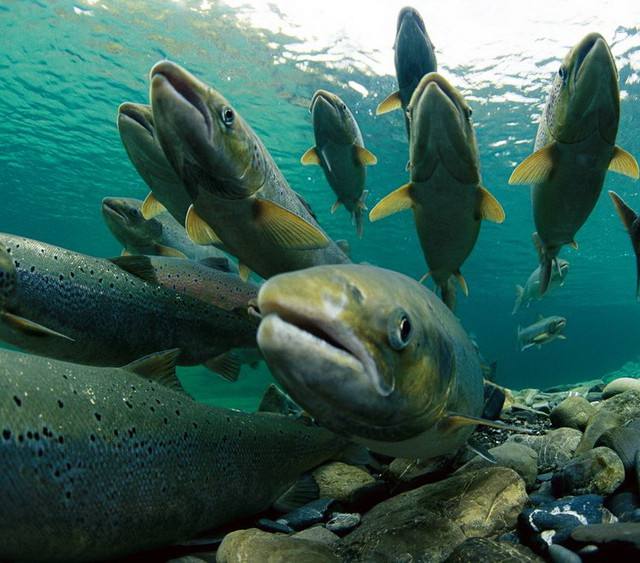(单词翻译:单击)
听力文本
This is Scientific American — 60-Second Science. I'm Emily Schwing.
Sex. It drives people to do crazy things. Animals, too. They'll make unsettling sounds, perform complex dances or show off giant plumes of colorful feathers. And, famously, salmon will swim hundreds of kilometers upstream to get down to business. They also inadvertently rework the landscape.
"Adult salmon spend most of their life out in the ocean and then they come in to freshwater to mate." Washington State University ecologist Alex Fremier.
"What the female salmon will do is, she digs a hole in the streambed."
That little hole is called a redd. That's where the salmon lays her eggs. And Fremier says when she builds it, she basically “unpacks” the stream bed, making all those loose sands and gravels more mobile. High water and flooding events move that sediment, which in turn exposes bedrock to further erosion.
"It's quite impressive. We did not expect to have salmon, in some cases, changing the vertical position of a river channel up to 30 percent more than it would have without salmon in it."

Fremier hypothesized that salmon not only influence landscape evolution, but that the evolution of salmon as a species itself has a landscape-level impact. To test the idea, he and colleagues recreated salmon redds in an experimental flume. Then they compared findings from the flume with real field observations. They cross-referenced all that data with discoveries from a study that modelled river profile erosion over five million years.
"We were stunned by the fact that it actually had a larger scale effect, given that we account for tectonic uplift, the big floods, like a lot of flood water moving downstream, different conditions of the gravel sizes on the river. I think we were all surprised by the fact that salmon could have such a large effect at that million-year scale." The study is in the journal Geomorphology.
So the next time you're hip-deep in water angling for the big one, just remember: were it not for the risqué behavior of your future dinner, the terrain around you could look vastly different.
Thanks for listening for Scientific American — 60-Second Science. I'm Emily Schwing.
参考译文
这里是科学美国人——60秒科学。我是埃米莉·施温。
性,驱使人类做出疯狂的事情。动物也一样。动物会发出令人不安的声音,跳起复杂的舞蹈,又或者是炫耀巨大的彩色羽毛。而出名的是鲑鱼,它们会逆流而上数百公里去“办事”。它们还在无意之中改变了地貌。
“成年鲑鱼一生中大部分时间都在海里,它们会游到淡水中去交配。”华盛顿大学的生态学家亚历克斯·弗莱米尔说道。
“雌性鲑鱼会在河床上挖个洞。”
这个小洞被称为“鲑鱼产卵区”。即鲑鱼产卵的地方。弗莱米尔表示,雌性鲑鱼挖好洞以后会在河床上产卵,让所有散沙和碎石更易流动。高水位和洪水会移动这些沉积物,反过来使基石暴露在外,进一步腐蚀。
“这令人印象深刻。在某些情况下,与没有鲑鱼相比,我们并没有想到鲑鱼的存在会使河道垂直距离的改变多30%。”
弗莱米尔假定鲑鱼不仅会影响地形演化,而且鲑鱼这一物种自身的进化也会对地貌产生影响。为了验证这个想法,弗莱米尔和同事在实验水槽中重建了鲑鱼的产卵区。然后,他们对比了水槽和实地观察结果。他们参照了一项研究中的数据,该研究模拟了500多万年河流剖面的腐蚀情况。
“即使我们已经考虑到构造隆升、顺流而下的大洪水、河水中的碎石大小不同等因素,但是鲑鱼所产生影响的规模要更大这一事实还是让我们震惊不已。我们都对鲑鱼所产生的重大影响与数百万年的沉积相当而感到吃惊。”这项研究结果发表在《地形学》期刊上。
所以,下次你进水里抓大个鲑鱼时,要记住:如若不是你未来晚餐(指鲑鱼)这一有伤风化的行为,你周围的地形可能会大不相同。
谢谢大家收听科学美国人——60秒科学。我是埃米莉·施温。
译文为可可英语翻译,未经授权请勿转载!
重点讲解
重点讲解:
1. get down to business 着手办正事,开始讨论实质问题;
例句:So much for polite introductions. it's now time to get down to business.
礼貌的介绍就到此为止。现在该谈正事了。
2. in turn 继而;转而;反过来;
例句:All theories originate from practice and in turn serve practice.
任何理论都来源于实践,反过来为实践服务。
3. account for 考虑;
例句:Besides the challenges of the client demands, we also had to account for the flexible nature of our work environment.
除了客户所要求的一些挑战外,我们还需要考虑我们工作环境的灵活性。
4. angle for (间接迂回地)猎取,谋取,博取;
例句:We angled for carp.
他们正在钓鲤鱼。


